Citroen C5 2017 (RD/TD) / 2.G Owner's Manual
Manufacturer: CITROEN, Model Year: 2017, Model line: C5, Model: Citroen C5 2017 (RD/TD) / 2.GPages: 348, PDF Size: 10.72 MB
Page 211 of 348

209
C5_en_Chap08_en-cas-de-panne_ed01-2016
Removing the pipe and cartridge
F Turn the pipe assembly 2 to the left until it contacts the unit.
F
D
isconnect the union 1 from the cartridge
by turning it a quarter turn anti-clockwise.
F
E
xtract the pipe assembly 2 , then
disconnect the union 3 from the air delivery
pipe by turning it a quarter turn anti-
clockwise. Beware of discharges of fluid.
The expiry date of the fluid is indicated
on the cartridge.
The sealant cartridge is designed for
single use; even if only partly used, it
must be replaced.
After use, do not discard the cartridge
into the environment, take it to an
authorised waste disposal site or a
CITROËN dealer.
Do not forget to obtain a new sealant
cartridge, available from CITROËN
dealers or from a qualified workshop.
F
R emove the pipe assembly 2
.
F S upport the compressor vertically.
F
U
nscrew the cartridge 4 from the bottom.
To fit the new cartridge and new pipe, carry out
these operations in reverse order.
8
In the event of a breakdown
Page 212 of 348
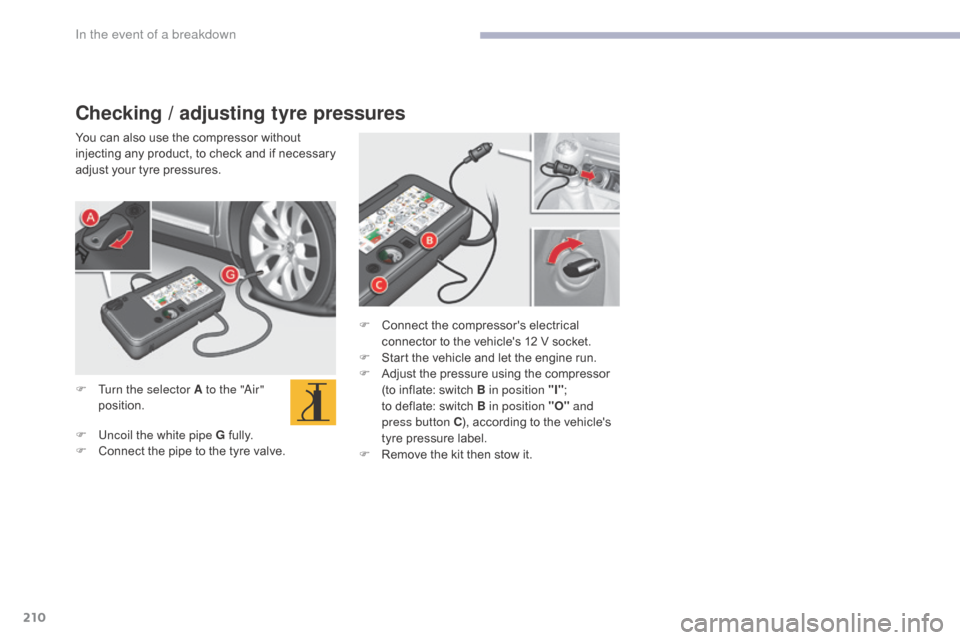
210
C5_en_Chap08_en-cas-de-panne_ed01-2016
Checking / adjusting tyre pressures
You can also use the compressor without
injecting any product, to check and if necessary
adjust your tyre pressures.
F
T
urn the selector A to the "Air"
position.
F
U
ncoil the white pipe G fully.
F
C
onnect the pipe to the tyre valve. F
C
onnect the compressor's electrical
connector to the vehicle's 12 V socket.
F
S
tart the vehicle and let the engine run.
F
A
djust the pressure using the compressor
(to inflate: switch B in position "I" ;
to
deflate: switch B in position "O" and
press button C ), according to the vehicle's
tyre pressure label.
F
R
emove the kit then stow it.
In the event of a breakdown
Page 213 of 348
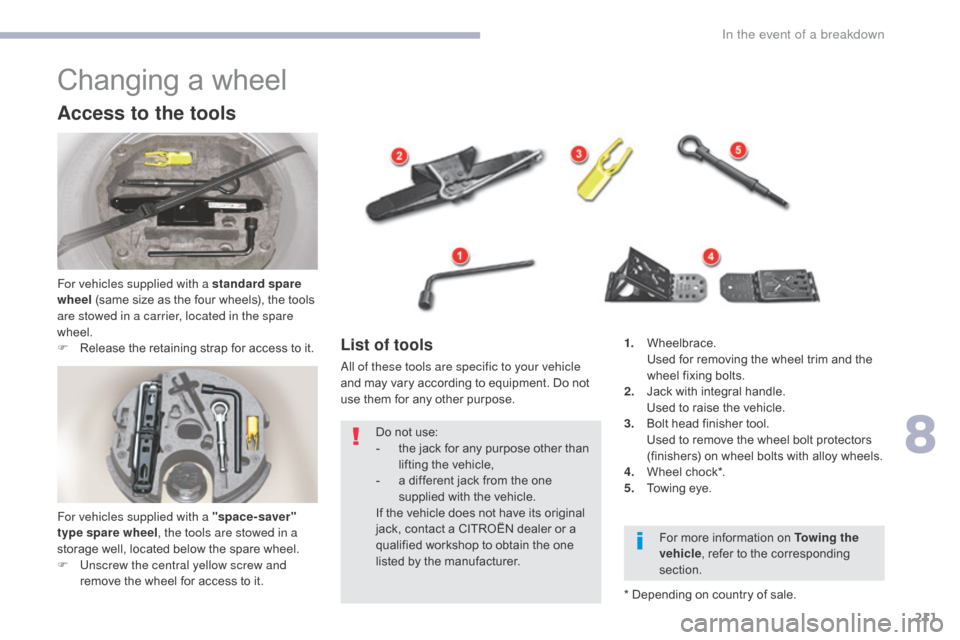
211
C5_en_Chap08_en-cas-de-panne_ed01-2016
Changing a wheel
Access to the tools
For vehicles supplied with a standard spare
wheel (same size as the four wheels), the tools
are stowed in a carrier, located in the spare
wheel.
F
R
elease the retaining strap for access to it.
List of tools
All of these tools are specific to your vehicle
and may vary according to equipment. Do not
use them for any other purpose. 1.
W
heelbrace. U
sed for removing the wheel trim and the
wheel fixing bolts.
2.
J
ack with integral handle.
U
sed to raise the vehicle.
3.
B
olt head finisher tool.
U
sed to remove the wheel bolt protectors
(finishers) on wheel bolts with alloy wheels.
4.
Wh
eel chock*.
5.
T
owing eye.
Do not use:
-
t
he jack for any purpose other than
lifting the vehicle,
-
a d
ifferent jack from the one
supplied with the vehicle.
If the vehicle does not have its original
jack, contact a CITROËN dealer or a
qualified workshop to obtain the one
listed by the manufacturer. For more information on Towing the
vehicle
, refer to the corresponding
section.
* Depending on country of sale.
For vehicles supplied with a "space-saver"
type spare wheel
, the tools are stowed in a
storage well, located below the spare wheel.
F
U
nscrew the central yellow screw and
remove the wheel for access to it.
8
In the event of a breakdown
Page 214 of 348

212
C5_en_Chap08_en-cas-de-panne_ed01-2016
Access to the spare wheel
Removing the boot floor
F Saloon: raise the boot floor and fold in two.
F T ourer : raise the boot floor and hook it
using the retractable handle. Secure the
hook to the top part of the boot.
Removing the standard spare
wheel
F Detach the strap, then push the wheel for wards so as to be able to lift it.
Repositioning the standard spare
wheel
F Position the spare wheel flat in the boot, then pull it towards you.
F
N
ext place the toolbox inside the wheel,
then secure the assembly using the strap.
Removing the "space-saver"
spare wheel
F Unscrew the central nut.
F R emove the fixing parts (nut and bolt).
F
T
ake the spare wheel from the rear and lift
it towards you.
F
R
emove the wheel from the boot.
In the event of a breakdown
Page 215 of 348

213
C5_en_Chap08_en-cas-de-panne_ed01-2016
The tyre pressures are indicated on the
label located on the left-hand centre
door pillar.
Tyre pressures are given on this label
for different vehicle loading conditions.Repositioning the "space-saver"
spare wheel
F Return the spare wheel to its housing above the toolbox.
F
U
nscrew the nut on the bolt by a few turns.
F
P
lace the fixing parts (nut and bolt) in the
middle of the wheel.
F
T
ighten the central nut until it clicks to
secure the wheel.
Repositioning the boot floor
F Release the boot floor to return it to its initial position.
8
In the event of a breakdown
Page 216 of 348
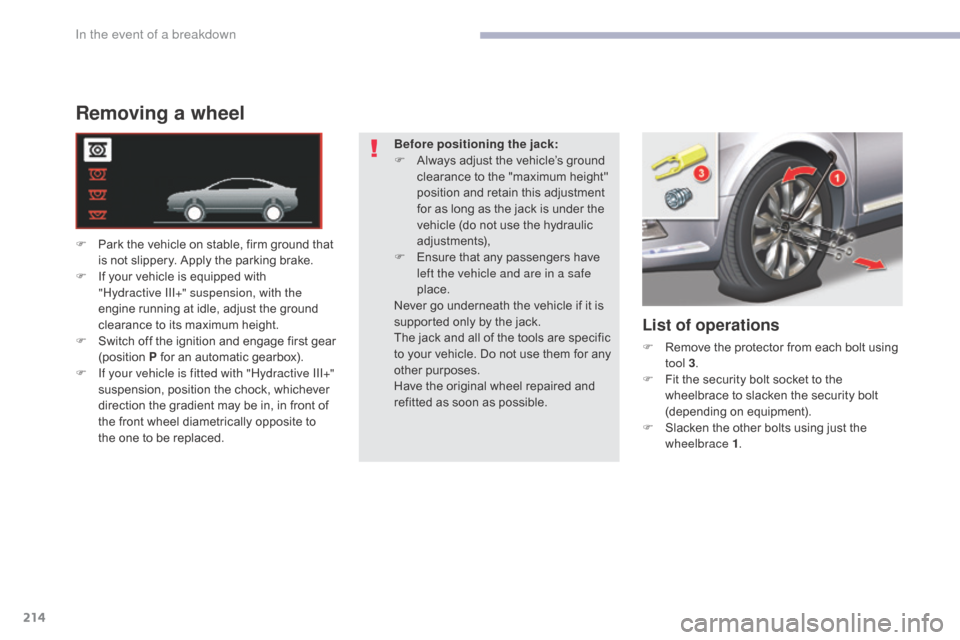
214
C5_en_Chap08_en-cas-de-panne_ed01-2016
Removing a wheel
F Park the vehicle on stable, firm ground that is not slippery. Apply the parking brake.
F
I
f your vehicle is equipped with
"Hydractive
III+" suspension, with the
engine running at idle, adjust the ground
clearance to its maximum height.
F
S
witch off the ignition and engage first gear
(position P for an automatic gearbox).
F
I
f your vehicle is fitted with "Hydractive III+"
suspension, position the chock, whichever
direction the gradient may be in, in front of
the front wheel diametrically opposite to
the one to be replaced.
List of operations
F Remove the protector from each bolt using tool 3 .
F
F
it the security bolt socket to the
wheelbrace to slacken the security bolt
(depending on equipment).
F
S
lacken the other bolts using just the
wheelbrace 1 .
Before positioning the jack:
F
A
lways adjust the vehicle’s ground
clearance to the "maximum height"
position and retain this adjustment
for as long as the jack is under the
vehicle (do not use the hydraulic
adjustments),
F
E
nsure that any passengers have
left the vehicle and are in a safe
place.
Never go underneath the vehicle if it is
supported only by the jack.
The jack and all of the tools are specific
to your vehicle. Do not use them for any
other purposes.
Have the original wheel repaired and
refitted as soon as possible.
In the event of a breakdown
Page 217 of 348
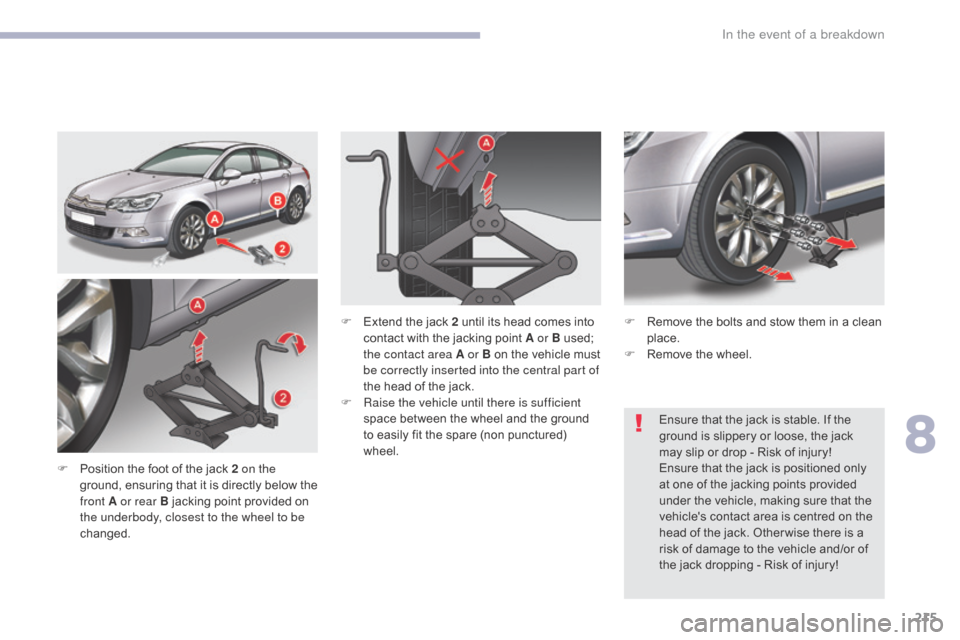
215
C5_en_Chap08_en-cas-de-panne_ed01-2016
F Position the foot of the jack 2 on the ground, ensuring that it is directly below the
front A or rear B jacking point provided on
the underbody, closest to the wheel to be
changed. Ensure that the jack is stable. If the
ground is slippery or loose, the jack
may slip or drop - Risk of injury!
Ensure that the jack is positioned only
at one of the jacking points provided
under the vehicle, making sure that the
vehicle's contact area is centred on the
head of the jack. Other wise there is a
risk of damage to the vehicle and/or of
the jack dropping - Risk of injury!
F
E
xtend the jack 2 until its head comes into
contact with the jacking point A or B used;
the contact area A or B on the vehicle must
be correctly inserted into the central part of
the head of the jack.
F
Ra
ise the vehicle until there is sufficient
space between the wheel and the ground
to easily fit the spare (non punctured)
wheel. F
R
emove the bolts and stow them in a clean
place.
F
R
emove the wheel.
8
In the event of a breakdown
Page 218 of 348

216
C5_en_Chap08_en-cas-de-panne_ed01-2016
List of operations
Fitting a wheel
Wheel for temporary use
Your vehicle may be fitted with a spare wheel
which is different to those on the vehicle. When
fitting the spare wheel, it is normal to notice
that the wheel bolt washers do not come into
contact with the wheel rim. The spare wheel is
secured by the conical tapering of the wheel
bolt’s shaft.
When refitting the original wheel, ensure that
the wheel bolt contact sur faces are clean and
in good condition. F
L
ower the vehicle to the ground.
F
L
ower the jack 2 and remove it.
F
F
it the wheel on the hub.
F
F
it and tighten the bolts by hand.
F
P
re-tighten the security bolt using the
wheelbrace 1 fitted with the security bolt
socket (depending on equipment).
F
P
re-tighten the other bolts using just the
wheelbrace 1 .
In the event of a breakdown
Page 219 of 348
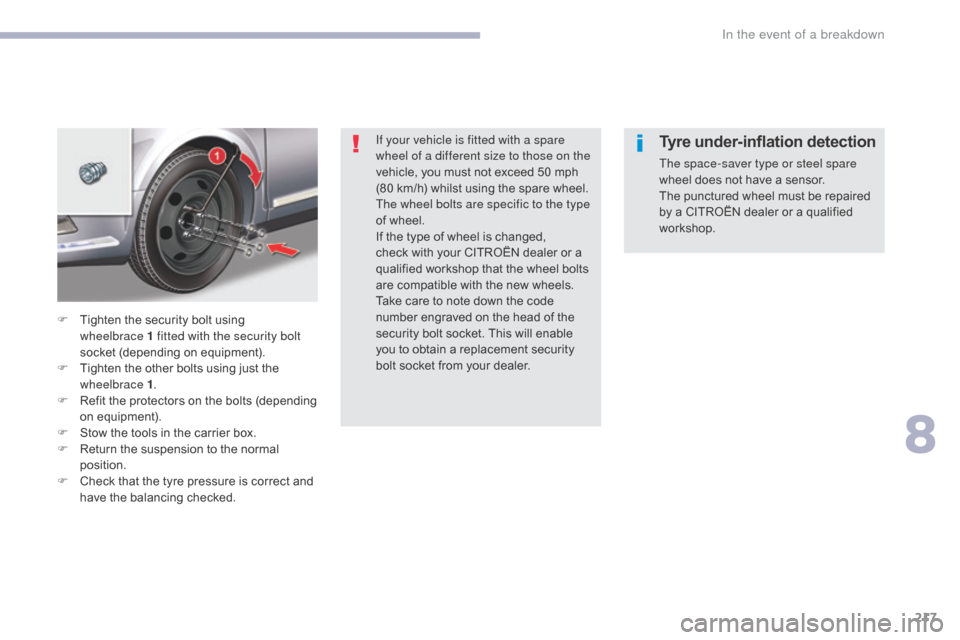
217
C5_en_Chap08_en-cas-de-panne_ed01-2016
If your vehicle is fitted with a spare
wheel of a different size to those on the
vehicle, you must not exceed 50 mph
(80 km/h) whilst using the spare wheel.
The wheel bolts are specific to the type
of wheel.
If the type of wheel is changed,
check with your CITROËN dealer or a
qualified workshop that the wheel bolts
are compatible with the new wheels.
Take care to note down the code
number engraved on the head of the
security bolt socket. This will enable
you to obtain a replacement security
bolt socket from your dealer.
F
T
ighten the security bolt using
wheelbrace
1 fitted with the security bolt
socket (depending on equipment).
F
T
ighten the other bolts using just the
wheelbrace 1 .
F
R
efit the protectors on the bolts (depending
on equipment).
F
S
tow the tools in the carrier box.
F
R
eturn the suspension to the normal
position.
F
C
heck that the tyre pressure is correct and
have the balancing checked.Tyre under-inflation detection
The space-saver type or steel spare
wheel does not have a sensor.
The punctured wheel must be repaired
by a CITROËN dealer or a qualified
workshop.
8
In the event of a breakdown
Page 220 of 348
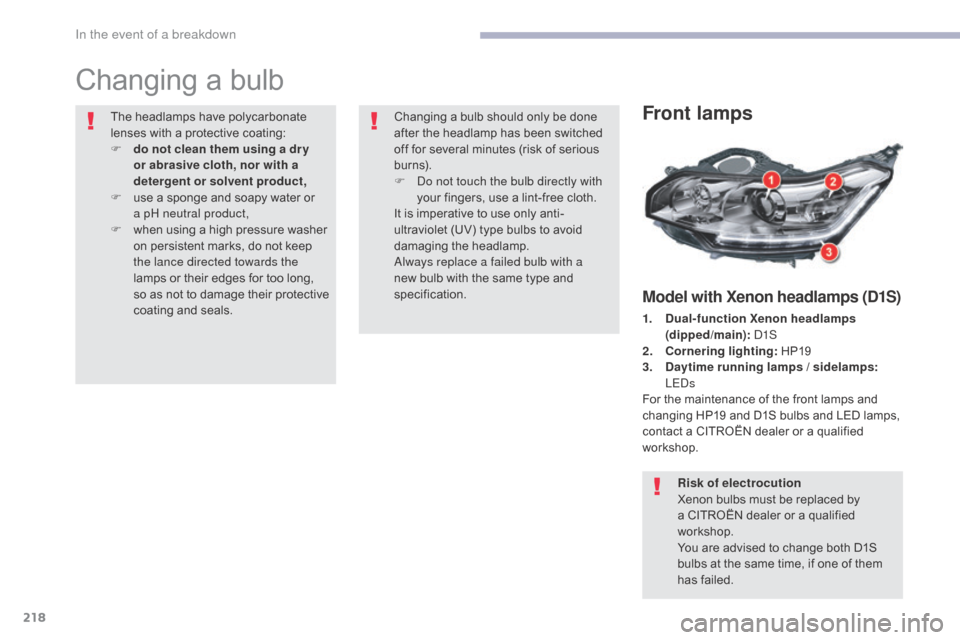
218
C5_en_Chap08_en-cas-de-panne_ed01-2016
Changing a bulb
Front lamps
Model with Xenon headlamps (D1S)
1. Dual-function Xenon headlamps (dipped/main): D1S
2.
C
ornering lighting: HP19
3.
D
aytime running lamps / sidelamps:
LEDs
For the maintenance of the front lamps and
changing HP19 and D1S bulbs and LED lamps,
contact a CITROËN dealer or a qualified
workshop.
Risk of electrocution
Xenon bulbs must be replaced by
a CITROËN dealer or a qualified
workshop.
You are advised to change both D1S
bulbs at the same time, if one of them
has failed.
The headlamps have polycarbonate
lenses with a protective coating:
F
d
o not clean them using a dr y
or abrasive cloth, nor with a
detergent or solvent product,
F
u
se a sponge and soapy water or
a
pH neutral product,
F
w
hen using a high pressure washer
on persistent marks, do not keep
the lance directed towards the
lamps or their edges for too long,
so as not to damage their protective
coating and seals. Changing a bulb should only be done
after the headlamp has been switched
off for several minutes (risk of serious
burns).
F
D
o not touch the bulb directly with
your fingers, use a lint-free cloth.
It is imperative to use only anti-
ultraviolet (UV) type bulbs to avoid
damaging the headlamp.
Always replace a failed bulb with a
new bulb with the same type and
specification.
In the event of a breakdown